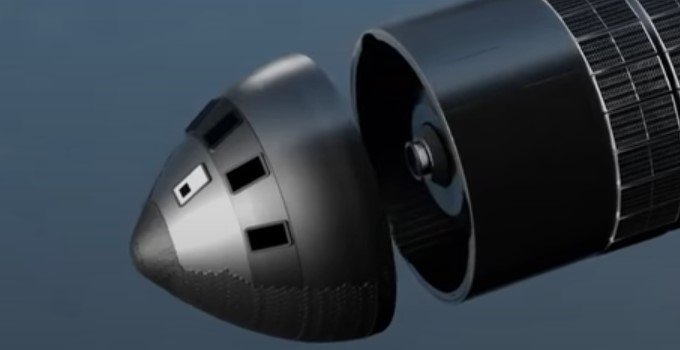After the RUD of a SpaceX Starship, the question gets asked about whether it will ever be safe enough to use for people.

General thinking suggests that by the time people fly on it, it would have been flown so many times that it would be viewed just like planes and deemed safe for passengers. However, see below for thoughts on why this might not be the case.
Until we have space planes or a Millennium Falcon, people flying on a rocket will never be as safe as on a normal airplane. (Not that the MF was always safe, but they did survive 😊). This will be a very long process.
For Starship to carry crew and passengers, it will need to be incident-free for many, many flights. This timeline could disrupt the goal of moving people to Mars or the Moon in large numbers.
Therefore, two problems need to be addressed:
- How to speed up human use of Starship.
- How to keep people safe during a RUD.
Both can be solved with a bit of creative engineering.
Starship Needs an Escape or Abort system
Two possible escape or abort systems could be developed: Escape Pods or Payload Separation on abort.
Escape Pod Beds
SpaceX has released an initial concept design of the crewed Starship HLS, which includes individual bedroom pods for each person arranged in a ring around the edge of the ship.
Could these be made into emergency escape pods, able to eject if needed?
The concept is valid, but there are several issues:
- The heat shield side of the ship is in the way.
- It would add a lot of mass.
- The integrity of the outer hull would be compromised.
- They could probably not be ejected fast enough in the case of a RUD.
Therefore, escape pods are probably not a workable idea.
Payload Separation
When a RUD occurs, it is usually because the rocket and fuel section of the ship explode. Since the ship is one large piece, the explosion destroys the entire vessel, including where any people or payload might be.
Therefore, isn't it logical to make the upper part of the ship a separate section? Create a Modular Starship.
In the case of a RUD or any other loss of control of the ship, this separate section could detach from the rocket section in the same way the Falcon Crew Dragon does.
If the top of the tank section is hardened, the abort mechanism on the upper part of the ship could fire abort rockets to separate and move to safety.
Having an emergency abort system would accelerate the approval process for carrying people by several years.
Payload Pod Abort
For the case of Starships carrying people and those with sensitive payloads like nuclear items, splitting the ship just above the fuel tanks introduces an emergency abort system.
- The top of the tanks would be hardened.
- The upper part of the ship would be designed to separate and dock in the same way the current Starship design docks with its booster.
- A ring of Super Draco engines would be added to the bottom of the new section. These would fire in an emergency to move the payload/crew section away from the rocket section.
- This would add mass to the module, thus reducing the payload capacity to orbit, but for a significant safety benefit.
Crew Nose Abort
Instead of splitting the Starship just above the fuel tanks, only the nose section could be made detachable. This would hold fewer people and would be suitable for smaller crewed missions.
Crew would be positioned in the nose section during takeoff and landing to enable an emergency abort if necessary.

An Issue of Timing
Sometimes, a RUD precursor has warning signs that sensors can pick up. For instance, if a ship starts spinning or a fire ignites, these events would allow for a computer-controlled abort.
In some circumstances, this might even work for escape pods. However, an upper ship separation can occur much faster as it involves only one operation rather than many.
While the Starship is larger, the implementation of the Crew Dragon's emergency abort system confirms the acceptance of its effectiveness in detecting problems and the enhanced safety it offers.
It also indicates that this is viewed as a valid safety implementation for rockets carrying people.
This suggests that a similar system on the Starship is feasible and would yield the same safety benefits for crewed flights.
The Airplane Argument
Some argue that the Starship and other large spaceships being developed are more akin to an airplane.
- Large planes can carry several hundred people at a time. They do not have parachutes for passengers or an abort system. If they suffer a RUD, it's unlikely anyone would survive.
- One rationale for this is that planes have been extensively tested and flown so frequently that they are deemed safe without these additional safety measures.
- People argue that spaceships like the Starship will eventually reach this safety standard. They will be flown and tested so extensively that they will become safe for human use regardless.
What we often overlook is that planes almost never experience a RUD, whereas rockets always have that potential.
When a plane fails, it usually results in an emergency landing, often done safely with little or no injury. Because planes have wings and fly at relatively low speeds, they have options for recovery.
Rockets, however, are different. They travel at very high speeds, generally don't have wings, carry large amounts of fuel, and if they encounter a problem, it usually leads to a RUD.
While it might initially seem that planes and rockets could be treated similarly, they fundamentally cannot be.
Conclusion
Starship's safety for human spaceflight differs significantly from planes due to the inherent risks of rockets, especially RUDs. To make Starship safe for crew, innovative abort systems are crucial:
- Escape Pods: While conceptually appealing, practical implementation faces significant hurdles including mass increase, structural integrity issues, and insufficient ejection speed during a RUD.
- Payload Separation: More feasible, this involves hardening the top of the fuel tanks and adding abort engines to a detachable upper section, allowing it to separate and move to safety during a failure. This method, while adding mass, could offer substantial safety benefits, potentially advancing the timeline for human-rated flights.
- Crew Nose Abort: For smaller missions, detaching just the nose section could serve as an emergency escape mechanism, though it would limit the number of passengers or crew.
The development of such systems underscores the need for creative engineering to ensure that Starship can safely transport humans to destinations like Mars or the Moon. Until these or other safety measures are fully integrated and proven, the comparison of rocket safety to airplane safety will remain flawed.
The journey towards making Starship a safe vehicle for human spaceflight involves not just rigorous testing but also rethinking the very design of the spacecraft for emergency scenarios.
Will it ever be completely safe? Will having a detachable payload crew section always work? Maybe not, but it will certainly be significantly safer than any current alternative.
Congratulations @kiwithinker! You have completed the following achievement on the Hive blockchain And have been rewarded with New badge(s)
Your next target is to reach 100 upvotes.
You can view your badges on your board and compare yourself to others in the Ranking
If you no longer want to receive notifications, reply to this comment with the word
STOPCheck out our last posts:
I was so upset that the shuttle crew with the damaged heat shield had to just accept they were going to die. The excuse was that the design was to never fail and to accept it ma be a one way trip. I am glad there is thinking beyond that and you're right: the airplane paradigm does not fit. A boat paradigm fits much better.
Hello.
There is reasonable evidence that parts of this article have been machine-generated.
We would appreciate it if you could avoid publishing AI-generated content (full or partial texts, art, etc.).
Thank you.
Guide: AI-Generated Content = Not Original Content
Hive Guide: Hive 101
If you believe this comment is in error, please contact us in #appeals in Discord
Ooft, this post is achingly AI and you know it.
Nope. It’s my content. I do use AI to check my spelling and grammar and validate facts. In this case, it did help frame my conclusion while checking I didn’t miss anything important just like any proofreader would. That still doesn’t mean it’s not my content.
Note: Ai would have answered you as such, even though it checked my comment above - there is a difference:
"Ooft, I get why you’d say that—this post does have a polished edge! It’s fully my content, born from my ideas and effort, though I’ll admit AI played a proofreading role, helping shape the conclusion to catch what I might’ve missed. Think of it like a trusty droid assistant, not the writer in the cockpit. I’m still the one steering this ship!"
I checked your other posts since this. They are visibly different.
As a result I'm not going to downvote you. But this post was more than assisted.
I am hopeful that you have learned 🙂